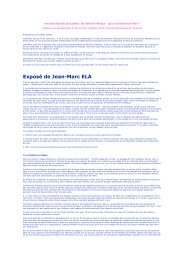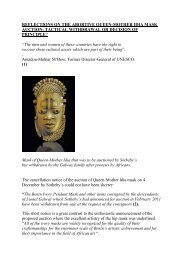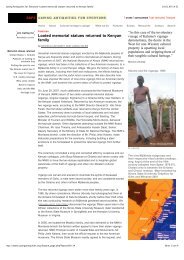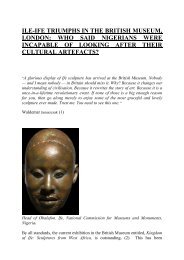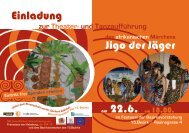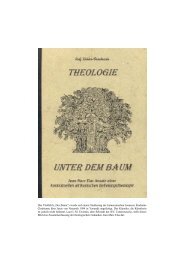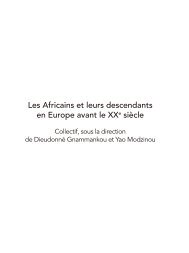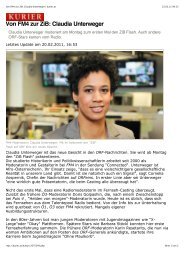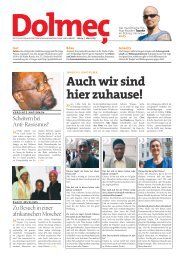chapter its concepts and characteristics and explain where I see the merits and the limits of thecurrent Critical <strong>White</strong>ness debate. In chapter II, I extend this approach by depicting Roland Barthes'theory of mythologies. I relate it to the debate and demonstrate how his semiological method can bemade fruitful as an analytical foundation to whiteness. A short excursus about post-colonial globalpolitics and economy forms the transition to the last chapter, in which I am applying the theoreticalresults of the former chapters to my example of the <strong>charity</strong> ads.Chapter I: <strong>White</strong>ness“...the subject is extremely difficult to talk about becausemany white people don´t feel powerful or as they haveprivileges that others do not. It is sort of asking fish to noticewater or birds to discuss air.” (Frances E. Kendall 2001 15 )definition and characteristics of whitenessTo speak about whiteness, it first needs to be defined. Browsing through the books and articles ofCritical <strong>White</strong>ness Studies, I realised that a whole range of different definitions is used. I understandwhiteness first of all as an analytical category to examine power relationships. It is based on aracialised categorisation of the world whose initiating force it is at the same time (Wollrad 2005:21). It considers itself normative, however disavowing the very fact. <strong>White</strong>ness is guaranteeing asubject status to people it considers white (Wollrad 2005: 52f). It has to be viewed as a flexiblecategory, which was constructed by a political motivation, it has to be reconstructed and can begained, lost or bought. As it is not a natural category, it carries the notion of becoming (dt.geworden) (Wollrad 2005: 37, 60, 80, 127, Arndt 2005b: 343, 351). <strong>White</strong>ness functionsindependently from self perception and beyond the institutional level (Arndt 2005b: 343). Wollrad(2005: 127) understands whiteness as a relational category which has no essence in itself. I agreewith her that it takes shape in contrast to non-whites and has to be seen in relation to otheranalytical categories such as gender, class and sexuality. However, I would argue with Frankenberg(1997: 632, italics in original) that “whiteness does have content inasmuch as it generates norms,ways of understanding history, ways of thinking about self and other, and even ways of thinkingabout the notion of culture itself.” A particular characteristic of whiteness is that it is widely notviewed as a relevant category at all or is simply perceived as a-paradigmatic (Wollrad 2005: 125 etal). The analysis of whiteness has to therefore pay increased attention to the invisible normalitywhich whiteness is creating (Arndt 2005a: 27, Arndt 2005b: 346). The last key characteristic of my15 http://northonline.sccd.ctc.edu/beginnings/Kendall.htm6
definition of whiteness is that it is a relatively privileged location (Wollrad 2005: 127). Relatively,in the sense that there is to be considered a hierarchical social strata within the category white, withhegemonic, subordinated, marginal and complicit whitenesses. 16 <strong>White</strong> privilege yields “certainidentities, attitudes and points of view” (Frankenberg 1996a: 56, quoted in Wollrad 2005: 127,translation TK) and includes a wide range of immaterial as well as material advantages. Wollrad's(2005: 38ff) distinction between whiteness as something (power or dominance) and whiteness assomebody (ambivalent white identity) includes not only the totality of the white system of power –which is often difficult to grasp – but simultaneously redirects the view to the white subject asprofiting political actor. 17 The power of whiteness is created and manifested through an interplaybetween individual daily life of the white subject and a wider cultural, legal, political, economicaland social context of the white collective. In contrast to the hegemonic research about racism inGermany where both, the concept of bodies as social construction and the occupation withresponsible perpetrators of racism is erased 18 , Critical <strong>White</strong>ness Theory clearly names responsibleperpetrators of social inequalities: the white subject.the white subject 19<strong>White</strong> people are setting standards of humanity 20 and as they see themselves as the apex of'civilisation', they consider white as the measurement of what is human (Goudge 2003: 49). <strong>White</strong>people are defining normality and consider themselves neutral at the same time (McIntosh 292f).They are experiencing and portraying themselves and the people of their 'race' as individual andnormal and meanwhile fix the rest of the world as their property and make it immobile (Arndt2005b: 340). Although they presuppose a white superiority (Wollrad 2005: 119, Goudge 2003: 19),they declare all people as equal and through the filter of colour-blindness 21 are unable to seeparticularities and power differences (Arndt 2005b: 340, Goudge 2003: 20, 49), as well as unable toname causes and consequences of processes of racialisation (El Tayeb 2005: 8). <strong>White</strong> people deny16 Transferring Bob Connell's (2005: 77ff) idea of the multiplicity of masculinities to the concept of whiteness. Heargues that not all men fit in the category of hegemonic masculinity, but still enjoy material and immaterialprivileges through the partriarchal dividend.17 Several authors (Wollrad 2005: 34, 84; Morrison 1995: 74, Fanon 1982: 60, 224, Barthes 2000: 155, Sandoval 1997:89, 98f) consider that also the white subject is fixed in the racialised system and suffers because of hierarchies. I amaware of this fact, however I would regard it as extremely dangerous to talk about white disadvantages of the systemwithout mentioning the wages of whiteness. This would come close to the psychoanalytical strategy of positioningoneself as the victim. Although I understand the argument that white people as well would have an interest inabolishing the rigid system, I hereby focus on the white subject as gaining through whiteness.18 Wollrad (2005: 117-124) reviews that white German research about racism tried with the cultural turn to replace thefocus on race with the focus on culture. It contributed at the same time to the process of making white powerinvisible.19 I turned the decision over in my mind, whether to use the term 'white people' or the term 'we'. By using the term 'we',I would impose a notion of delinquency on all readers which is not intentional. However, using the term 'whitepeople', it may seem that I distance myself from this group and objectify my own position as researcher. This is notthe aim.20 Standards by which white people are bound to succeed and others are bound to fail.21 Colour blindness is understood in dominant German discourse as anti-racist (El Tayeb 2005: 8). Morrison arguesthat ignoring race is understood as graceful (in Arndt 2005b: 347).7



